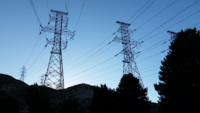
Photo from wikipedia
Abstract In order to achieve the typical goal of smart grid, the concept of electricity Internet of Things (eIoT) has been proposed to assist the monitoring and inspection of power… Click to show full abstract
Abstract In order to achieve the typical goal of smart grid, the concept of electricity Internet of Things (eIoT) has been proposed to assist the monitoring and inspection of power transmission line state, and optimize the asset utilization. The long power transmission line and the complex field operation environment urge the introduction of drones into the eIoT for fast power transmission line inspection, data collection from sensors for further big data analysis, adaptive control of power line voltage, etc. Additionally, drones can also act as a central communication control or relay point to serve the data exchange among sensors, drones and power transmission line maintenance personnel in the scenario where the conventional mobile communication service is not available. However, the fast mobility of drones may affect the signal transmission and position estimation performance, which may further deteriorate the networking performance. In order to solve this problem, a mobility compensation method is proposed, which includes the steps of frequency offset estimation and relative velocity calculation. Through the Monte Carlo simulations, the proposed algorithm shows favorable gains compared with the conventional ones.
Journal Title: Digital Communications and Networks
Year Published: 2020
Link to full text (if available)
Share on Social Media: Sign Up to like & get
recommendations!